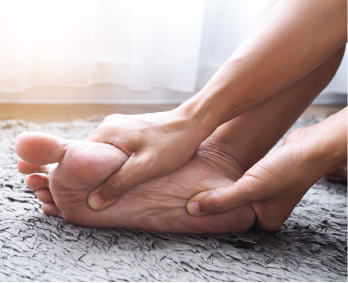
Kittima05 / shutterstock.com
The high prevalence and significant burden of osteoarthritis (OA) are well known. But it’s becoming apparent that OA research efforts don’t necessarily match disease prevalence or disability.
The International Foot and Ankle Osteoarthritis Consortium (IFOAC) is an international organization of volunteers that seeks to highlight a major and often overlooked problem in OA research—foot and ankle OA—and grow research efforts to ultimately improve patient outcomes. Many members of this group are actively involved in running large, epidemiological studies that seek to understand disease burden and risk factors of foot and ankle OA, as well as involved in designing and conducting large, randomized controlled trials to identify effective treatment targets. These activities fomented our united desire to seek common goals and, ultimately, better outcomes.
Background & Importance
Over previous decades, substantial research efforts have been directed toward understanding the pathogenesis of OA and testing treatments, predominantly for large, weight-bearing joints, such as the knee and hip. This focus is likely because these joints were considered the most affected in the lower limbs and because of the detrimental effect of knee and hip OA on mobility and daily function. It often comes as a surprise that OA of the foot affects 16.7% of people aged 50 and older, making it as common as knee OA (7.6–16.4%).1,2
When we consider individual foot joints, OA affects the first metatarsophalangeal joint more commonly than the hip (7.8% vs. 5.0–7.4%), while prevalence in the midfoot region is even higher (12%).1-3 Foot OA also results in substantial disability. Nearly three-quarters of patients with symptomatic radiographic OA report disabling foot pain, which is concerning given such pain causes significant problems with completing daily functional tasks, such as walking, balancing, stair climbing and rising from a chair.1,4,5
The limited research in the field of foot and ankle OA includes a lack of focus on treatment. A recent search identified only four randomized trials on treatment for first metatarsophalangeal joint OA,6–9 six for ankle OA10–15 and an additional six randomized feasibility or pilot studies.16–21 This contrasts with 54 randomized trials on land-based exercise alone for knee OA, identified in a 2015 Cochrane Review.22 Clearly, it’s time to bring this overlooked problem into focus.
Officially established in 2019, IFOAC aims to provide a forum for the development of a sustainable network of clinicians, researchers & other health professionals who share a common interest in driving foot & ankle OA research forward.
The IFOAC
It’s unclear why the foot has received considerably less research attention than the knee and hip. However, the IFOAC aims to grow research in the field. The organization was officially established in 2019 to provide a forum for the development of a sustainable network of clinicians, researchers and other health professionals who share a common interest in driving foot and ankle OA research forward.
In reality, the work to develop the IFOAC began informally many years earlier through a series of international collaborations across continents. Several workshops and special interest groups held during the 2007–2012 ACR annual scientific meetings sparked initial conversations, along with subsequent meetings at EULAR and eventual expansion to the Osteoarthritis Research Society International (OARSI) and British Society for Rheumatology (BSR) meetings.
Today, the IFOAC is governed by five steering committee members and early career researcher representatives from the U.S., the U.K. and Australia. In the short time since its inception, formal membership has grown in the past two years to include clinicians and researchers from a multitude of countries. Information is readily shared via Twitter
(@ifoac), and relevant articles of interest are posted on the organization’s website (https://tinyurl.com/6m4mzuta). Potential members can easily see information and gauge their interest in particular topics.
The IFOAC has a number of strategic objectives through which it seeks to increase the recognition of the effect of foot and ankle OA, and identify effective treatment targets. These objectives include:
- To organize research priorities to maximize progress and impact of scientific studies to advance our understanding of foot and ankle OA epidemiology, etiology, prevention and effective management;
- To compile current and progressive evidence to develop a clear global definition for foot and ankle OA to enable us to answer important epidemiological questions, assess the burden of disease and progress to intervention trials;
- To agree on a core set of outcomes that all principal investigators use to assess foot and ankle pain and OA;
- To make recommendations for research priorities in foot and ankle OA, with the intention of the ongoing dissemination in future conferences;
- To contribute to guideline development and/or consensus statements; and
- To prioritize the development and evaluation of effective treatments to improve the lives of people with foot and ankle OA.
Progress to Date
Significant work toward these objectives has commenced. In 2019, the IFOAC had its first global working group discussion meeting at the OARSI World Congress in Toronto. In this session, the group highlighted current knowledge of, and future directions for, clinical and radiographic case definitions for foot and ankle OA, provided estimates for the prevalence of foot and ankle OA according to specific radiographic definitions and discussed priorities for the subsequent 12 months to help move the field forward. This work builds on foundations laid at previous group discussions held at ACR and EULAR meetings. Initial discussions included the range of foot conditions and problems that affect patients with rheumatic diseases, such as hallux valgus and pes planus.
Although long-term goals are to address foot problems in our patients, the decision was made to start with OA, given its prevalence and important role in mobility limitations. To emphasize the importance of this focus, two separate editorials highlighting the overlooked burden of foot and ankle OA, and identifying major gaps in our understanding of the disease and its management, including the lack of a clinical definition, have been published in Arthritis Care & Research.23,24
In May this year, the IFOAC initiated a consensus exercise on the epidemiology, diagnosis, burden, outcome assessment and treatment of foot and ankle OA to begin to more formally identify and prioritize these research gaps.
The organization is financially supported by the U.K. Centre for Sport, Exercise and Osteoarthritis Research Versus Arthritis and closely connected with other international rheumatology groups and learned societies with interests in promoting foot and ankle OA research. For instance, IFOAC members are actively involved with the ACR, BSR, the Australian Rheumatology Association, OARSI and Outcome Measures in Rheumatoid Arthritis Clinical Trials (OMERACT).
Call to Arms (or Legs)
Now established, our goal is to promote the IFOAC to the rheumatology field more broadly, to gain greater representation and to ensure the research agenda and objectives meet the needs of clinicians, patients and researchers. To that end, we welcome members to join the IFOAC, bring their voice to the group and help improve outcomes for this group of patients who are underserved by research.
Those interested can sign up online (https://tinyurl.com/6m4mzuta). Membership is free. We want to hear your voices, concerns and ideas. Rather than calling our concerns out into the great void, we believe our collective focus will bring much needed light to this hidden burden of foot and ankle OA, as well as to future work on other important foot conditions in rheumatology.
 Kade L. Paterson, PhD, BPod, BAppSci(Hons), is an emerging leadership fellow with the Australian National Health and Medical Research Council, and a Dame Kate Campbell senior research fellow with the Centre for Health, Exercise and Sports Medicine at the University of Melbourne. He is also a certified sports podiatrist with Lakeside Sports Medicine Centre. Dr. Paterson’s research expertise is in lower limb biomechanics during walking and running, and he has a special interest in the clinical and biomechanical effects of foot-based interventions for musculoskeletal conditions.
Kade L. Paterson, PhD, BPod, BAppSci(Hons), is an emerging leadership fellow with the Australian National Health and Medical Research Council, and a Dame Kate Campbell senior research fellow with the Centre for Health, Exercise and Sports Medicine at the University of Melbourne. He is also a certified sports podiatrist with Lakeside Sports Medicine Centre. Dr. Paterson’s research expertise is in lower limb biomechanics during walking and running, and he has a special interest in the clinical and biomechanical effects of foot-based interventions for musculoskeletal conditions.

Dr. Hannan
Marian T. Hannan, DSc, MPH, is a professor of medicine at Harvard Medical School and senior scientist at the Marcus Institute for Aging Research, Hebrew SeniorLife, Boston. She conducts epidemiological musculoskeletal studies with a research focus on foot disorders and biomechanics, as well as arthritis, osteoporosis and hip fracture.
 Lara Chapman, MSc, BPod, is a specialist podiatrist at Harrogate and District NHS Foundation Trust and a research associate at Leeds Institute of Rheumatic and Musculoskeletal Medicine, University of Leeds, U.K. Her research focuses on foot and ankle outcome measures in rheumatic and musculoskeletal diseases.
Lara Chapman, MSc, BPod, is a specialist podiatrist at Harrogate and District NHS Foundation Trust and a research associate at Leeds Institute of Rheumatic and Musculoskeletal Medicine, University of Leeds, U.K. Her research focuses on foot and ankle outcome measures in rheumatic and musculoskeletal diseases.

Dr. Roddy
Edward Roddy, DM, FRCP, is a professor of rheumatology at Keele University, U.K., and a consultant rheumatologist in the Midlands Partnership NHS Foundation Trust. His research interests include common musculoskeletal foot problems, particularly gout and osteoarthritis. He leads a program of epidemiological studies and randomized clinical trials.

Dr. Menz
Hylton B. Menz, PhD, BPod, is a podiatrist and National Health and Medical Research Council Senior Research Fellow at La Trobe University, Melbourne, Victoria, Australia. His broad research disciplines are human movement, rehabilitation and rheumatology, with a particular focus on musculoskeletal foot problems in older people. His research extends from laboratory-based biomechanical studies to analysis of epidemiological datasets and the conduct of clinical trials.

Dr. Bowen
Catherine Bowen, PhD, BPod, is a professor of podiatry at the University of Southampton, U.K. Her research focuses on maintenance of musculoskeletal foot and ankle health for active living with two main themes: the development of imaging techniques to detect changes not readily seen on clinical observation, and optimization of care for management of foot health for people with arthritis.
Authors’ note: The authors of this article represent the IFOAC Steering Committee.
References
- Roddy E, Thomas MJ, Marshall M, et al. The population prevalence of symptomatic radiographic foot osteoarthritis in community-dwelling older adults: Cross-sectional findings from the clinical assessment study of the foot. Ann Rheum Dis. 2015 Jan;74(1):156–163.
- Pereira D, Peleteiro B, Araújo J, et al. The effect of osteoarthritis definition on prevalence and incidence estimates: A systematic review. Osteoarthritis Cartilage. 2011 Nov;19(11):1270–1285.
- Thomas MJ, Peat G, Rathod T, et al. The epidemiology of symptomatic midfoot osteoarthritis in community-dwelling older adults: Cross-sectional findings from the Clinical Assessment Study of the Foot. Arthritis Res Ther. 2015 Jul 13;17(1):178.
- Menz HB, Dufour AB, Casey VA, et al. Foot pain and mobility limitations in older adults: The Framingham Foot Study. J Gerontol A Biol Sci Med Sci. 2013 Oct;68(10):1281–1285.
- Menz HB, Lord SR. Foot pain impairs balance and functional ability in community-dwelling older people. J Am Podiatr Med Assoc. 2001 May;91(5):222–229.
- Munteanu, SE, Landorf KB, McClelland JA, et al. Shoe-stiffening inserts for first metatarsophalangeal joint osteoarthritis: A randomized trial. Osteoarthritis Cartilage. 2021 Apr;29(4):480–490.
- Menz HB, Auhl M, Tan JM, et al. Effectiveness of foot orthoses versus rocker-sole footwear for first metatarsophalangeal joint osteoarthritis: Randomized trial. Arthritis Care Res (Hoboken). 2016 May;68(5):581–589.
- Munteanu SE, Zammit GV, Menz HB, et al. Effectiveness of intra-articular hyaluronan (Synvisc, hylan G-F 20) for the treatment of first metatarsophalangeal joint osteoarthritis: A randomized placebo-controlled trial. Ann Rheum Dis. 2011 Oct;70(10):1838–1841.
- Shamus J, Shamus E, Gugel RN, et al. The effect of sesamoid mobilization, flexor hallucis strengthening, and gait training on reducing pain and restoring function in individuals with hallux limitus: A clinical trial. J Ortho Sports Phys Ther. 2004 Jul;34(7):368–376.
- Cohen MM, Altman RD, Hollstrom R, et al. Safety and efficacy of intra-articular sodium hyaluronate (Hyalgan) in a randomized, double-blind study for osteoarthritis of the ankle. Foot Ankle Int. 2008 Jul;29(7):657–663.
- Karatosun V, Unver B, Ozden A, et al. Intra-articular hyaluronic acid compared to exercise therapy in osteoarthritis of the ankle. A prospective randomized trial with long-term follow-up. Clin Exp Rheumatol. 2008 Mar–Apr;26(2):288–294.
- Nunley JA, Adams SB, Easley ME, et al. Prospective randomized trial comparing mobile-bearing and fixed-bearing total ankle replacement. Foot Ankle Int. 2019 Nov;40(11):1239–1248.
- Herrera-Perez M, Alrashidi Y, Galhoum AE, et al. Debridement and hinged motion distraction is superior to debridement alone in patients with ankle osteoarthritis: A prospective randomized controlled trial. Knee Surg Sports Traumatol Arthrosc. 2019 Sep;27(9):2802–2812.
- Saltzman CL, Hillis SL, Stolley MP, et al. Motion versus fixed distraction of the joint in the treatment of ankle osteoarthritis: A prospective randomized controlled trial. J Bone Joint Surg Am. 2012 Jun 6;94(11):961–970.
- DeGroot HI, Uzunishvili S, Weir R, et al. Intra-articular injection of hyaluronic acid is not superior to saline solution injection for ankle arthritis: A randomized, double-blind, placebo-controlled study. J Bone Joint Surg Am. 2012 Jan 4;94(1):2–8.
- Paterson KL, Hinman RS, Metcalf BR, et al. Podiatry intervention versus usual general practitioner care for symptomatic radiographic osteoarthritis of the first metatarsophalangeal joint: A randomized clinical feasibility study. Arthritis Care Res (Hoboken). 2021 Feb;73(2):250–258.
- Halstead J, Chapman GJ, Gray JC, et al. Foot orthoses in the treatment of symptomatic midfoot osteoarthritis using clinical and biomechanical outcomes: A randomized feasibility study. Clin Rheumatol. 2016 Apr;35(4):987–996.
- Divecha HM, Zubairy AI, Barrie JL, et al. First metatarsophalangeal joint arthrodesis versus proximal phalanx hemiarthroplasty for hallux rigidus: Feasibility study for a randomized controlled trial. Trials. 2014 Mar 13;15:79.
- Salk RS, Chang TJ, D’costa WF, et al. Sodium hyaluronate in the treatment of osteoarthritis of the ankle: A controlled, randomized, double-blind pilot study. J Bone Joint Surg Am. 2006 Feb;88(2):295–302.
- Marijnissen ACA, Van Roermund PM, Van Melkebeek J, et al. Clinical benefit of joint distraction in the treatment of severe osteoarthritis of the ankle: Proof of concept in an open prospective study and in a randomized controlled study. Arthritis Rheum. 2002 Nov;46(11):2893–2902.
- Glazebrook M, Burgesson BN, Younger AS, Daniels TR. Clinical outcome results of total ankle replacement and ankle arthrodesis: A pilot randomized controlled trial. Foot Ankle Surg. 2021 Apr;27(3):326–331.
- Fransen M, McConnell S, Harmer A, et al. Exercise for osteoarthritis of the knee. Cochrane Database of Sys Rev. 2015;1:CD004376.
- Golightly YM, Gates LS. Foot osteoarthritis: Addressing an overlooked global public health problem. Arthritis Care Res (Hoboken). 2021 Jun;73(6):767–769.
- Paterson KL, Arnold JB. A defined problem: Working towards a clinical definition of foot osteoarthritis. Arthritis Care Res (Hoboken). 2021 Sep;73(9):1228–1230.

